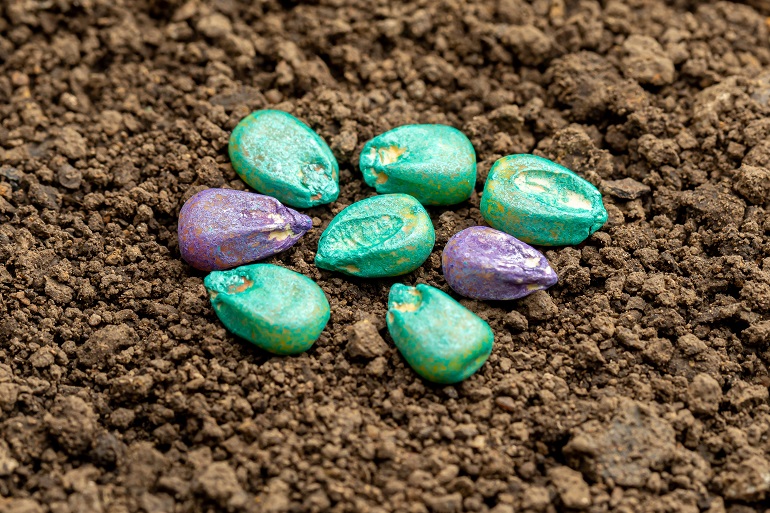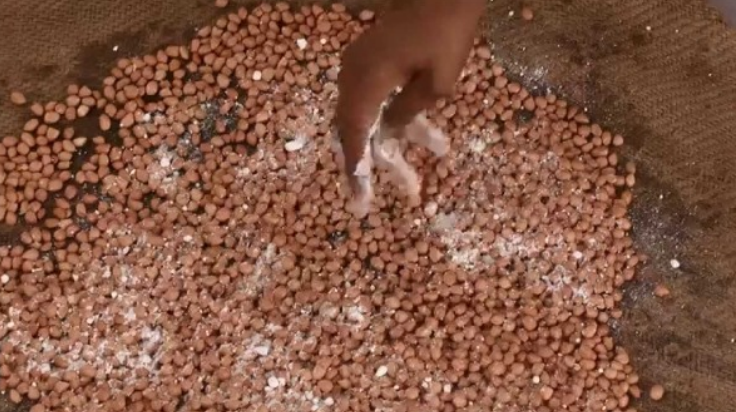Seed treatment and its importance for agriculture and food safety

This post is also available in:
This post is also available in:
![]() हिन्दी (Hindi)
हिन्दी (Hindi)
What is seed treatment?
Seed treatment is the application of fungicide, insecticide, or both to the seeds to disinfect (deep-seated) and disinfect them (over seed coat) from seed-borne or soil-borne pathogenic organisms and storage insects. It also refers to subjecting the seed to solar energy exposure.

The importance of seed treatment
Seed treatments are crucial in protecting seeds and seedlings against diseases and insect pressure from planting. There are hundreds of pathogens and insects that can damage or even kill the seeds or seedlings before they have a chance to develop. This can negatively influence the crop’s progress throughout the growing season and significantly impact the yield results at harvest time. Seed treatment:
- Is effective in preventing the spread of plant diseases, both systemic and non-systemic. It can control systemic diseases such as smut of wheat, Helminthosporium blight of barley, and loose and covered smut of oats. Additionally, it can effectively control non-systemic diseases that infect seeds during the harvest or storage period, such as Fusarium blight of barley, oats, rice, sorghum, etc., through appropriate seed treatment.
- Protects seeds from seed rot and seedling blights. Once the seeds are planted, the protective coating around the seed acts as a barrier against seed-borne and soil-borne organisms.
- Improve germination – Seed treatment improves germination by controlling surface molds and flora. These microorganisms, while non-pathogenic, can still infect the seeds during moist harvesting and storage.
- Protects from storage insects and pests. However, for complete protection, it is also necessary to treat the seeds with an insecticide. Conditions under which seed must be treated:
- Injured seeds: Seeds are susceptible to mechanical injury during threshing, drying, or processing. Any damage to the seed coat creates an ideal entry point for fungi (or pests), which can either result in the seed’s death or weaken its viability.
- Diseased seeds: Seeds can become infected by disease organisms during harvest or processing and storage.
- Undesirable soil conditions: Seeds are sometimes planted in unfavorable soil conditions, such as damp or cold soils. These conditions favor the growth of certain spores, making seed infection and damage possible.
- Disease-free seed: Seed treatment provides a reliable defense against diseases and soil-borne organisms. It safeguards weak seeds, facilitating successful germination and ensuring healthy seedling development.
Causes of poor seed treatments
- Incorrect fungicide selection: Using inappropriate fungicides, outdated dust, or other ineffective treatments may provide limited protection against soil fungi.
- Inadequate dosage: Insufficient fungicide application on the seed leads to ineffective seed treatment.
- Carelessness: Merely using the best available fungicides and equipment for seed treatment does not guarantee proper treatment. It is essential to exercise care and attention to detail, including machine adjustments, to ensure effective seed treatment.
Types of seed treatment
Types of seed treatment include:
- Physical seed treatment: This involves mechanical or physical methods such as scarification (scratching the seed coat), stratification (exposing the seeds to cold temperatures), or hot water treatment.
- Chemical seed treatment: Chemicals are applied to the seeds to control diseases, pests or to enhance germination and vigor. Examples include fungicides, insecticides, and seed disinfectants.
- Biological seed treatment: Beneficial microorganisms, such as bacteria or fungi, are applied to the seeds to promote plant growth, protect against diseases, or enhance nutrient availability. This method is often used in organic farming.
- Nutritional seed treatment: Essential nutrients or growth-promoting substances are applied to the seeds to improve their nutrient content or enhance seedling vigor.
- Genetic seed treatment: Genetic techniques are used to enhance the desired traits of the seeds, such as resistance to diseases, pests, or environmental stresses.
- Environmental seed treatment: Seeds are exposed to specific environmental conditions, such as temperature or humidity, to stimulate germination or break seed dormancy.
References
- K. A. Jeffs 1978. Seed Treatment. Collaborative International Pesticides Analytical Council. 101.
- K. Vanangamudi, G.Sastry, S. Kalaivani, A. Selvakumari, M. Vanangamudi, P. Srimathi. 2010 Seed Quality Enhancement: Principles and Practices. Scientific Publishers – 485
- V. K. Agarwal, James B. Sinclair 2017. Principles of Seed Pathology. CRC Press, Volume-II
Find more detailed information about the importance of treatment in soybean in the other article by the author.









































































